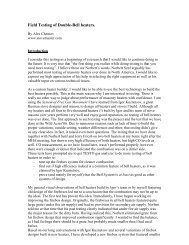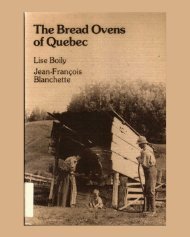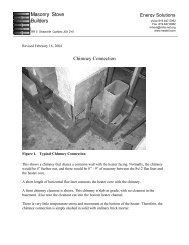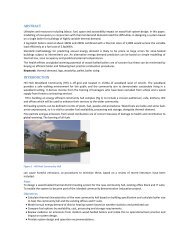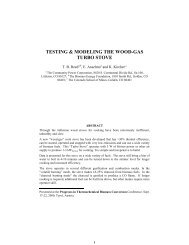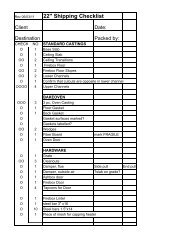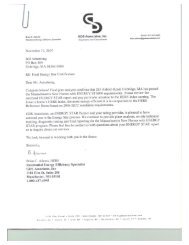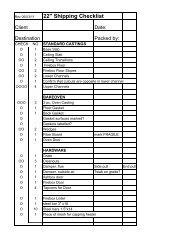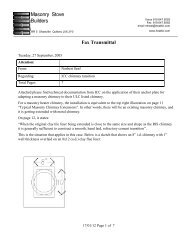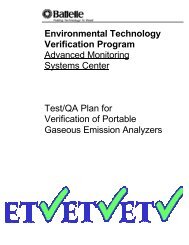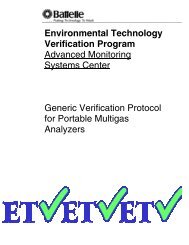96-TA28.07 The Hearth as an Element of the Sustainable House - A ...
96-TA28.07 The Hearth as an Element of the Sustainable House - A ...
96-TA28.07 The Hearth as an Element of the Sustainable House - A ...
Create successful ePaper yourself
Turn your PDF publications into a flip-book with our unique Google optimized e-Paper software.
<strong>96</strong>-<strong>TA28.07</strong><br />
<strong>The</strong> semi-volatile soluble org<strong>an</strong>ic compounds cool upon exposure to <strong>the</strong> atmosphere <strong>an</strong>d<br />
condense into a very fine mist <strong>of</strong> chemically complex tar droplets, with 90% <strong>of</strong> <strong>the</strong><br />
particles smaller th<strong>an</strong> 1 micron. Of <strong>the</strong> soluble org<strong>an</strong>ic compounds, <strong>of</strong> most concern are<br />
<strong>the</strong> polycyclic aromatic hydrocarbons (PAH’s), m<strong>an</strong>y <strong>of</strong> which are Cl<strong>as</strong>s A<br />
carcinogens 15 .<br />
Volatile org<strong>an</strong>ic compounds<br />
Little data is available on volatile org<strong>an</strong>ic compounds (VOC’s). <strong>The</strong> Americ<strong>an</strong> study<br />
cited above found VOC emissions <strong>of</strong> 0.4 g/kg from a m<strong>as</strong>onry heater.<br />
A COMPARISON OF PM EMISSIONS MEASURING METHODS<br />
<strong>The</strong> McNear Brick Tests<br />
In 1995, Western States Clay Products Association (WSCPA) sponsored a series <strong>of</strong> field<br />
tests <strong>of</strong> 2 m<strong>as</strong>onry fireplaces. Three separate emissions me<strong>as</strong>uring methods were used<br />
simult<strong>an</strong>eously–a modified EPA-M5G, <strong>an</strong> AES <strong>an</strong>d OM41 <strong>as</strong> modified for use at Lopez<br />
Labs. Testing w<strong>as</strong> conducted at <strong>the</strong> McNear brickyard in S<strong>an</strong> Rafael, CA.<br />
Methods used in this study<br />
Fueling protocol. A fueling protocol developed by <strong>the</strong> author <strong>an</strong>d colleague J. Frisch at<br />
Lopez Labs w<strong>as</strong> used in most <strong>of</strong> this study. <strong>The</strong> Lopez protocol differs from EPA-M28 in<br />
that it uses real world fuel. Limited earlier testing 16,17 on two m<strong>as</strong>onry heaters indicated<br />
that use <strong>of</strong> dimensioned lumber could reduce PM emissions by approximately 50%.<br />
<strong>The</strong> Lopez Labs fueling protocol uses cordwood. Instead <strong>of</strong> sizing, it is a specification<br />
for describing <strong>the</strong> fuel load in enough detail to allow <strong>the</strong> original initial condition in <strong>the</strong><br />
firebox to be reconstructed at a later date.<br />
Three separate PM me<strong>as</strong>urement methods were run simult<strong>an</strong>eously in this study.<br />
Modified EPA-M5G. This method w<strong>as</strong> conducted by S. McNear from McNear Brick, <strong>the</strong><br />
site <strong>of</strong> <strong>the</strong> testing, <strong>an</strong>d Dr. D. Ja<strong>as</strong>ma from Virginia Polytechnic. It consisted <strong>of</strong> a Method<br />
5G dilution tunnel <strong>an</strong>d filter train. Two filter trains were run in parallel to provide data<br />
redund<strong>an</strong>cy. Flow rate through <strong>the</strong> tunnel w<strong>as</strong> me<strong>as</strong>ured with a pitot tube <strong>an</strong>d held<br />
const<strong>an</strong>t by me<strong>an</strong>s <strong>of</strong> a variable speed f<strong>an</strong>. A sample w<strong>as</strong> drawn from <strong>the</strong> tunnel at a<br />
const<strong>an</strong>t rate, <strong>an</strong>d <strong>the</strong>refore at a fixed proportion to <strong>the</strong> total tunnel flow.<br />
Automated Emissions Sampler (AES). This method w<strong>as</strong> conducted by P. Tiegs <strong>an</strong>d J.<br />
Tiegs from OMNI Environmental (Beaverton, Oregon). <strong>The</strong> AES unit is a portable<br />
emissions sampling system. Flue g<strong>as</strong> is drawn from <strong>the</strong> stack <strong>an</strong>d <strong>the</strong> sample travels<br />
through a heated filter for collection <strong>of</strong> particulate matter. <strong>The</strong> filter is followed by a<br />
cartridge containing a sorbent resin for collecting semi-volatile hydrocarbons. Flue g<strong>as</strong><br />
oxygen concentration is me<strong>as</strong>ured by <strong>an</strong> electrochemical cell.<br />
A const<strong>an</strong>t sample flow is maintained <strong>an</strong>d a subsample <strong>of</strong> this flow is pumped into a bag<br />
for later laboratory <strong>an</strong>alysis <strong>of</strong> average carbon dioxide <strong>an</strong>d carbon monoxide<br />
concentration.<br />
5



